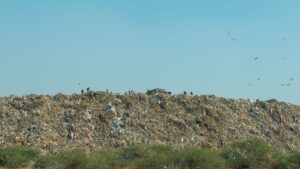Chythenyen Devika Kulasekaran
Burning garbage is choking Delhi’s health, environment, livelihoods and finances. It is high time that the AAP government starts addressing the problem of waste, not when it is thrown away, but when it is produced.
 “This is an emergency situation and the people would be evacuated, if they were in our country”, lamented health experts from London who examined effluent gas samples from the Okhla waste-to-energy (WTE) plant in Delhi, says Ranjit Devraj, an editor at the journal, Science Development. A headline in 2015, from a leading daily newspaper read, “Delhi CM Kejriwal promises to shut Okhla waste-to-energy plant if elected to power.” Fast-forward to 2022, and another headline read, “Kejriwal promises to set up waste-to-energy plants on war footing if elected to power”.
“This is an emergency situation and the people would be evacuated, if they were in our country”, lamented health experts from London who examined effluent gas samples from the Okhla waste-to-energy (WTE) plant in Delhi, says Ranjit Devraj, an editor at the journal, Science Development. A headline in 2015, from a leading daily newspaper read, “Delhi CM Kejriwal promises to shut Okhla waste-to-energy plant if elected to power.” Fast-forward to 2022, and another headline read, “Kejriwal promises to set up waste-to-energy plants on war footing if elected to power”.
Since the inception of the first failed WTE plant in Delhi in 1987, successive governments have ignored the people, science, environment, climate, livelihoods, geopolitics and economics while budgeting for Delhi’s garbage. Delhi already has four WTE plants — one each at Ghazipur, Narela, Okhla and Tehkhand — to burn about 8,000 tons of municipal solid waste or about 70 per cent of its total waste. However, the Solid Waste Monitoring Committee (SWMC) has recommended expanding the capacity to burn an additional 6,402 tonnes of waste using new WTEs. By pushing for big, centralised waste-to-energy plants, 2023’s Delhi budget, themed “Saaf, Sundar aur Aadhunik Delhi” (Clean, Beautiful and Modern Delhi), is doomed to make Delhi “toxic, dark and unliveable”.
The Delhi budget earmarks funds for 11 mobile vans to identify the sources of Delhi’s hazardous pollution. But the biggest elephant in the room is the waste-to-energy plant. According to the Intergovernmental Panel on Climate Change (IPCC), every ton of waste incinerated in a WTE plant will emit 700-1,200 kg of CO2. The 8,000 tons of garbage burnt every day in Delhi’s WTE plants is equivalent to the CO2 emissions from about 20,00,000 cars.
An international study led by IIT-Madras on Delhi’s air pollution found that the major reason for its deteriorating air quality is the presence of chloride-rich particles that are produced primarily from the burning of plastics in WTE plants. The emissions of dioxins and furans from all three facilities in 2020 were several times over the permissible limits and in the Okhla WTE plant, their concentrations were 10 times higher. What this means is that people living in South Delhi and in the vicinity of the plant are at extremely high risk of getting various diseases including cancer, respiratory illnesses, heart diseases, immune system defects, increased allergies and congenital abnormalities.
The SWMC, formed under the aegis of the National Green Tribunal (NGT), proposes to add 6,402 tons of additional capacity to existing WTE plants. For example, the Okhla WTE plant expansion involves increasing the waste treatment capacity by 50 per cent from the current 2,000 tonnes per day (TPD) to 3,000 TPD. For the communities living nearby, it is like moving from a fire to an inferno. This augmentation of WTE capacity is despite the fact that Delhi’s waste is ill-suited for WTE plants as it has a very low calorific value — about 1,300 Kcal/kg, which is well below the minimum requirement of 1,800 kcal/kg. According to the report ‘India’s Waste to Energy Paradigm’, WTE plants receive a slew of government support in the form of Viability Gap Funding (VGF) of up to 50 per cent of the project cost, low-interest loans, tipping fees, beneficial electricity generation prices, tax exemptions and free land. However, necessity should be the mother of invention. Not corporate greed.
Incinerators have managed to “hang on” and pollute the environment albeit under different guises. When they were first introduced in 1874 to burn garbage, they were called “destructors” and veritably opposed by the public due to air pollution. Since then, the industry has adopted more palatable terms such as “incinerators”, “waste-to-energy” and “carbon capture systems” by piggybacking on “climate change”. Ironically, the highly polluting Okhla WTE plant was awarded carbon credits for 2,62,791 tons of CO2 according to UNFCCC. While the Global North is increasingly moving away from waste to energy, they are making a strong comeback in the Global South where environmental standards are substantially lower.
Despite such a dangerous track record, WTE plants have continued to be seen as a solution to the garbage problem because of propaganda. Burning waste is a bigger enemy to Delhi’s air quality than seasonal stubble burning. But by repeating the rhetoric that waste can be converted to electricity and “nothing is waste”, the WTE industry has influenced the opinion of the legislature in favour of burning all of Delhi’s waste. It has even made them believe that burning garbage in WTE plants is the only viable, clean, green and renewable option. However, burning garbage is choking Delhi’s health, environment, livelihoods and finances. It is high time that the government starts addressing the problem of waste, not when it is thrown away, but when it is produced.
This article was originally published in Indian Express and can be read here.
Centre for Financial Accountability is now on Telegram. Click here to join our Telegram channel and stay tuned to the latest updates and insights on the economy and finance.

